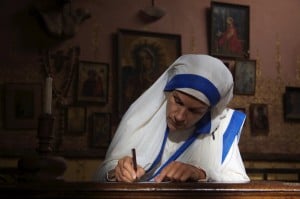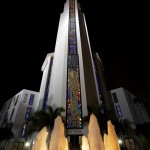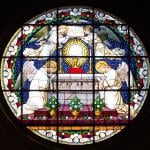It was hot, and we were tired. It was September 2000, our first trip to Rome, and our band of seven hearty travelers had embarked on a long walk through the streets of the city to the Piazza Navona.
The Piazza stands on the site of the first-century Stadium of Domitian. In its center, Bernini’s Fontana dei Quattro Fiumi (Fountain of the Four Horses) is topped by the Obelisk of Domitian, brought here in pieces from the Circus of Maxentius. Two other fountains mark each end of the piazza: The Fontana del Moro marks the southern end, with a basin and four Tritons sculpted by Giacomo della Porta, with a seventeenth century addition by Bernini: a statue of a Moor (or African) wrestling with a dolphin. At the north is the Fountain of Neptune, also created by Giacomo della Porta. In the late nineteenth century, sculptor Antonio Della Bitta added a statue of Neptune to make the fountain more symmetrical with the other.

The Piazza Navona is a bustling location full of flower stalls, sidewalk cafes, musicians, mimes and artists. Tourists and locals sat along the fountains’ stone retaining walls, savoring gelato or watching as artists painted on easels. The crowds made it difficult to pass and easy to become separated from one another.

At the edge of the piazza, its door facing the Fountain of the Four Horses, was a chapel. We’d already visited the four papal basilicas, and this small church was unimpressive by comparison; but we entered the cool space, grateful for silence and a moment of calm.

And there she was: a tiny skull in an ornamented reliquary. Quite by accident, we’d just met St. Agnes of Rome.
Little is known of the diminutive saint. She’s believed to have been a wealthy Roman maiden who dedicated herself to God, and who was martyred at the age of 13 defending her purity. She is shown in art holding a lamb–because of the similarity between her name and the Latin word for lamb, agnus.
Only Agnes’ skull is entombed there in Sant’Agnese in Agone. Her bones are preserved under the high altar of the Basilica di Sant’Agnese Fuori le Mura. It’s at the Basilica where, every year on January 21, two lambs representing Agnes’ purity are blessed. Later in the year, the wool from the lambs is used to weave the palliums, the distinctive stole-like vestment given by the pope to each new archbishop.
Last year I wrote about the blessing of the lambs. You can read that story here.
* * * * *
St. Agnes’ feastday is January 21. She is the patron of betrothed couples and chastity. She is also patron of the Children of Mary, Colegio Capranica of Rome, crops and gardeners, Girl Guides, girls, rape victims and virgins. She is also the patron of the diocese of Rockville Centre, New York.












